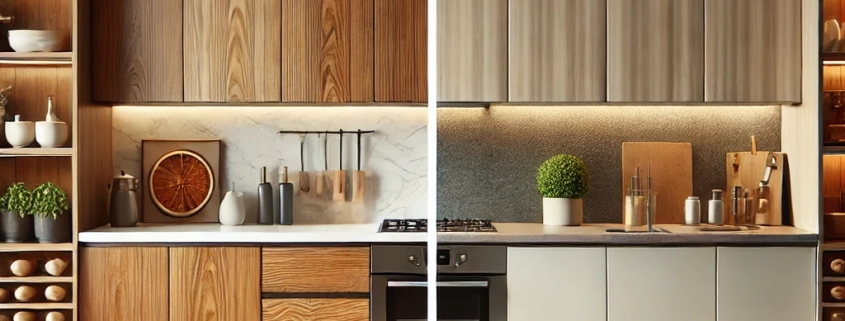Introduction
Cabinet-making is a nuanced art that requires careful consideration of a multitude of factors. Among these, the choice of material is perhaps the most critical. Central to this discussion is the ongoing debate between wood and laminate as the ideal material for cabinet making. Both materials come with a unique set of advantages and drawbacks, underlining the importance of understanding their characteristics before making a decision.
This article seeks to provide an in-depth comparison of wood and laminate, highlighting their key differences in terms of durability, appearance, cost, and maintenance. Durability is a key factor in cabinet making. A cabinet should not only be aesthetically pleasing but also sturdy enough to withstand daily use. This is where the choice between wood and laminate comes into play. Appearance, on the other hand, is largely dependent on personal preference. Another critical aspect to consider is cost. Often, the budget can be a deciding factor in choosing between wood and laminate. Lastly, maintenance is a crucial aspect of cabinet care. Each material has different maintenance requirements that can significantly impact the overall longevity and appearance of the cabinet.
In the following sections, we will delve deeper into each of these aspects, providing a comprehensive comparison between wood and laminate as materials for cabinet making. The goal is to equip you with the knowledge to make an informed decision that best suits your needs and preferences.
Understanding Wood Cabinets
Moving on from the introduction, let’s delve deeper into the specifics of wood cabinets. These are traditional cabinets that have been used for centuries, offering a classic and timeless appeal. Constructed using various types of wood, these cabinets are recognized for their natural grain patterns, which can be enhanced through staining or painting. Wood cabinets are a favored choice for homeowners who value aesthetics and longevity in their home interiors.
The Advantages of Wood Cabinets
Turning our attention to the advantages of wood cabinets, they undeniably offer a rich and elegant look that is hard to replicate. They are solid and sturdy, capable of standing up to wear and tear over the years. Wood cabinets can be refinished, meaning they can be repainted or stained to match evolving styles, making them a long-lasting option. Their versatility is another significant advantage as they can be custom-made to fit any size or design, offering limitless possibilities for a unique kitchen or bathroom design.
The Disadvantages of Wood Cabinets
However, like any other material, wood cabinets have their downsides. One of the primary disadvantages of wood cabinets is their cost. They are typically more expensive than their laminate counterparts due to the cost of the raw material and the craftsmanship involved. Wood also tends to warp and crack over time due to changes in temperature and humidity. Furthermore, they require more maintenance, regular cleaning, and occasional refinishing to keep them looking their best.
Different Types of Wood Used in Cabinet Making
When it comes to the varieties of wood used in cabinet making, there are several options to choose from. Hardwoods like oak, maple, and cherry are commonly used due to their durability and attractive grain patterns. Other options include pine, hickory, and birch, each offering unique characteristics in terms of color, grain, and overall appearance. Exotic woods like mahogany, teak, and bamboo are also used for high-end cabinets, offering a unique and luxurious aesthetic. The choice of wood variety can significantly influence the cost, durability, and look of the cabinets.
Understanding Laminate Cabinets
Before diving into the world of laminate cabinets, it’s important to first understand what exactly they are. Laminate cabinets are made by adhering a thin layer of plastic to a substrate of particleboard or MDF. The finish is a photographic image of wood grain, giving them the appearance of real wood. They come in a wide range of colors, patterns, and textures, allowing for a high degree of customization.
The Pros of Laminate Cabinets
One advantage of laminate cabinets is that they are generally more affordable than their wood counterparts. This is primarily due to the materials used in their construction, which are less expensive and more readily available. Additionally, laminate cabinets are easy to clean, resistant to stains, and don’t require the same level of maintenance as wood. They are also quite durable, and able to withstand the rigors of a busy kitchen or bathroom.
The Cons of Laminate Cabinets
However, laminate cabinets do come with their own set of disadvantages. They can be prone to chipping or peeling over time, and once damaged, they are difficult to repair. Unlike wood cabinets, laminate cabinets cannot be refinished or stained a different color if you decide to change your decor. This lack of longevity can be a significant drawback for some homeowners.
Several Types of Laminate Used in Cabinet Making
There are several types of laminate used in cabinet making. High-pressure laminate (HPL) is the most common and durable type. It’s created by pressing multiple layers of paper together at a high heat and pressure. Low-pressure laminate (LPL) or melamine is less durable but more affordable. It’s made by pressing a single layer of paper onto a particleboard. Lastly, a thermofoil is a type of laminate that’s heated and molded over MDF or particleboard. It’s very smooth and easy to clean, but less durable than HPL.
Comparison of Wood and Laminate Cabinets
Comparing the Durability of Wood and Laminate Cabinets
When comparing the durability of wood and laminate cabinets, it’s important to note that both materials have their strengths and weaknesses. Traditional wood cabinets are often praised for their long-lasting nature. They can withstand years of use without significant wear and tear, and minor damages such as scratches or dents can be easily repaired. On the other hand, laminate cabinets, especially those made from high-pressure laminate, are highly resistant to stains and moisture, making them a good choice for areas subject to spills or high humidity. However, they may be more prone to chipping and peeling, and repairing such damage can be more challenging than with wood.
Comparing the Aesthetic Appeal of These Materials
From an aesthetic perspective, wood and laminate cabinets each have a unique appeal. Wood cabinets offer a timeless, classic look that can range from rustic to elegant depending on the type and finish of the wood. They also have a natural grain pattern that adds depth and character to the cabinets. Laminate cabinets, while not able to fully replicate the natural grain of wood, can come surprisingly close, especially high-quality laminates. They also offer a broader range of colors and patterns, allowing for a more modern and bold design aesthetic.
Comparing the Costs
When it comes to cost, laminate cabinets generally offer a more economical choice. The price of wood cabinets can vary greatly depending on the type of wood used, with rare or exotic woods commanding higher prices. However, the initial cost of laminate cabinets can be significantly lower, especially when compared to high-end wood cabinets. It is worth noting though, that in the long run, the durability and repairability of wood can make it a more cost-effective choice.
Maintenance Requirements for Both Materials
Lastly, maintenance requirements for both materials must be considered. Wood cabinets require regular dusting and occasional polishing to maintain their luster and prevent drying or cracking. They are also more susceptible to damage from harsh cleaning chemicals. Laminate cabinets, on the other hand, are easy to clean with most household cleaners and are resistant to stains and spills. However, they must be protected from excessive heat and can be damaged by sharp objects.
Choosing Between Wood and Laminate
Consider the Environment Where the Cabinet Will Be Placed
Choosing between wood and laminate for cabinet making involves several factors. The first consideration is the environment where the cabinet will be placed. Both wood and laminate respond differently to various conditions such as humidity, heat, and usage. For instance, wood, being a natural material, tends to expand and contract depending on the humidity level. This can affect the cabinet’s durability and lifespan. On the other hand, while laminate is less sensitive to humidity, it might not withstand heat as well as wood does. Additionally, heavy usage can expose laminate cabinets to the risk of chipping, whereas wood cabinets are more resilient and easier to repair.
Take Into Account Your Aesthetic Preferences
Another essential factor when choosing cabinet material is aesthetic preference. Wood cabinets have a timeless appeal that brings warmth and character to any space. They offer a variety of grain patterns and can be stained or painted to match any decor. In contrast, laminate cabinets offer a sleek, modern look. They come in a wide range of colors and patterns, simulating the look of wood or other materials. Despite their different styles, both materials can create stunning cabinetry that enhances the overall look of a room.
The Pros and Cons of Both Wood and Laminate
Lastly, it’s crucial to understand that both wood and laminate have their pros and cons. Wood cabinets may require more maintenance and can be costly, but they are known for their durability and repairability. Laminate cabinets, while more economical, are stain-resistant and offer a wide variety of design options. However, they can be prone to chipping and are harder to repair. Understanding these aspects can help you make an informed decision that fits your personal preferences, budget, and needs.
Conclusion
In conclusion, the decision between wood and laminate for cabinet making depends significantly on several factors, all of which are unique to each situation. We have reviewed the main points, highlighting the durability, reparability, and timeless aesthetic of wood cabinets. On the other hand, we have also considered the cost-effective, stain-resistant, and wide-design availability of laminate cabinets. However, the drawbacks of each material have also been highlighted, from the high maintenance and cost of wood to the susceptibility to chipping and difficulty in repairing laminate.
Reiterating the importance of personal preference and environment, it’s clear that there is no one-size-fits-all answer. It ultimately comes down to what you, as the homeowner or designer, value most. If longevity and classic appeal are your top priorities, you may lean towards wood. However, if budget constraints and a modern aesthetic are more pertinent, laminate could be the more suitable choice.
Moreover, the environment in which the cabinets will be installed plays a crucial role in this decision. A humid environment may not be the best for wood cabinets due to potential warping, while a high-traffic area might not suit laminate cabinets because of their propensity to chip. Therefore, while we can provide the comparisons and considerations, the final decision lies in your hands.
Remember, choosing the right cabinet material is not just about its immediate appeal, but also its long-term suitability and adaptability to your lifestyle and environment. For exceptional cabinet making, choose Excalibur Cabinetry. Our skilled craftsmen deliver custom designs and high-quality construction to create beautiful and functional cabinets for your home.



